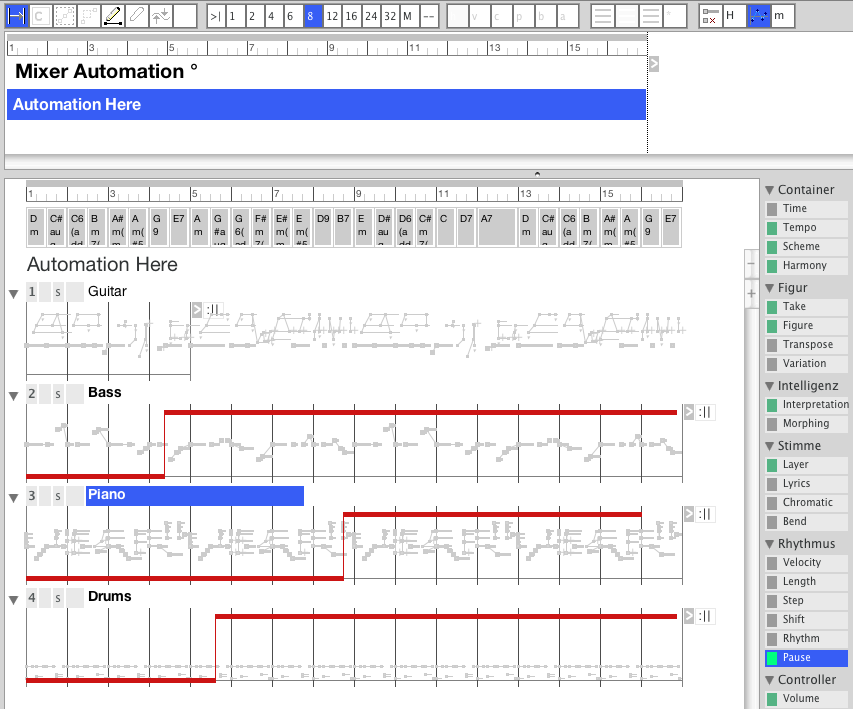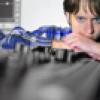
Posted
Hi,
I just came across this nice example that shows how to keep mixer automation (pause, volume, pan, reverb, whatnot) separate from musical content, stored in one or more global containers. The example file uses Pause only, but you can easily imagine what else could be stored in the "automation" container.
As a nice side effect, the musical content is quite cool too :listen:
The music is attached to this posting for download. Note that you need to enable the parameters-always-visible mode (see tool bar) to edit the Pause parameter for all instruments at the same time. Use the line drawing tool for this. Be careful using the Pause switch of the track, as it will replace the Pause parameter. with a constant value.
What is this good for?
One can more easily exchange the phrases (e.g. from a library) without affecting the overall mix. It also simplifies setting cues that do not meet container bounds. For short pieces with a flat structure, this straightforward method seems to be more appropriate.
EDIT: I'm not 100% sure, but you might need 1.1.6 to open the file. At least ist will sound better, because some issues with chords were fixed recently.
(Mixer Automation.cognac)
mixer_automation_196.cognac
(automation.png)

Sun, 2009-12-20 - 01:07 Permalink
As an alternative to this, I've found it works much better in my work flow, not to automate over the course of a container, but rather to have different containers with different volume-pan-reverb settings for different sections.
The advantages of this are that you can use the faders to adjust the levels without overwriting the rest of the automation, which makes setting level faster than draw-adjust/listen/draw-adjust/listen etc..
It avoids the possibility of accidentally automating something without realizing it. It gives a visual representation of the mix structure and lets you keeps mix notes and ideas in the container notes. It also lets you quickly copy all the mix settings to a new section of the score. You also never have to toggle in and out of hyperedit, and can keep the figure editing prioritized.
I would really like to be able to see automation curves in the background while working on a figure or another parameter though.
I mentioned before using pause is awkward because there is no visual representation that its occurring beyond the rare moment that both "display selected parameters" and the pause parameter are both on -- of course when both of these are on, nothing can be done on any instrument but edit the pause data.
This is especially true when the pause parameter is shorter than the figure and is repeating... In this case there is no graphic representation at all and one must just guess at where in its cycle it is falling under the figure.
The goal of displaying a parameter in the background would be to synchronize automation, and parameters. For examples, while drawing the shape of Control A I can can have a graphic representation of Control B in the background so that their curves can correspond, syncopate and interact with each other.
This would solve the pause issue as well -- by default the pause parameter could display in the background while editing the figure.
This still might be a little confusing as the pause parameter only acts on the anchor of a segment so while visually a symbol may fall under the pause graphic, it may not actually be paused.
Ideally synfire will soon have some sort of graphic indicator on the symbols themselves when they are being paused, so when scanning the instrument sheet looking for parts they can easily be ignored. Either method, or both would be a great help.
Sun, 2009-12-20 - 10:31 Permalink
[quote]I would really like to be able to see automation curves in the background while working on a figure or another parameter though.
Did you know you can select as many simultaneous parameters you like? (parameter selection is multi-select). The first is being edited, the others shown as background. This also works in the instrument sheet. And it considers inheritance and loops. :)
[quote]This still might be a little confusing as the pause parameter only acts on the anchor of a segment so while visually a symbol may fall under the pause graphic, it may not actually be paused.
It may not be easy to see at a glance, but it sounds fantastic. Instrument activity follows musical and motivical semantics rather than the computer clock. Especially with multiple instruments playing together, this sounds very natural. No DAW or notation software can do that.
Segments intended to emphasise the first note will have their anchor there anyway. If others have some up-beat ornamentation, it is only natural to preseve it.
Sun, 2009-12-20 - 10:54 Permalink
Super rad with the multi select on the parameters; especially since figure can be selected first to do exactly what I was asking.
I do like the way notes will hang over outside the pauses from a strictly musical perspective.
For scoring there are so many places where the music needs to stop abruptly to make way for dialog, sfx etc.
Its a minor problem and since I don't let phases loop anyway I don't really mind manually editing the parts in places where the last segment should play but with a clean cut on the bar.


